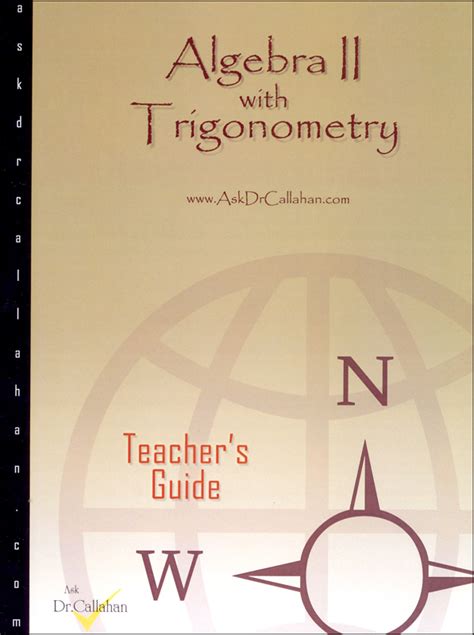Introduction
Prepare yourself for an exhilarating journey into the fascinating world of Algebra II Trig! This comprehensive guide will equip you with the knowledge, skills, and strategies necessary to conquer this challenging subject.

Unraveling the Basics
Trigonometric Functions
At the heart of Algebra II Trig lie six trigonometric functions: sine, cosine, tangent, cosecant, secant, and cotangent. These functions establish relationships between the angles and sides of a right triangle.
Identities and Equations
Trigonometric identities are useful equations that involve trigonometric functions. They can simplify expressions, solve equations, and provide valuable insights.
Graphing Trigonometric Functions
Understanding the graphs of trigonometric functions is crucial for visualizing their behavior and solving problems. These graphs exhibit periodic patterns and possess distinct characteristics.
Applications in Various Fields
Trigonometry finds widespread applications in diverse fields, including:
- Engineering: Modeling and analyzing physical systems
- Architecture: Designing buildings and structures
- Astronomy: Calculating distances and positions of celestial objects
- Navigation: Determining location and direction
- Medicine: Measuring physiological signals and analyzing medical data
Real-World Examples
To illustrate the practical significance of Algebra II Trig, consider the following examples:
- Engineering: An engineer designs a bridge by calculating the angles and lengths of its components using trigonometric functions.
- Astronomy: An astronomer uses trigonometry to determine the distance to a star by measuring its parallax, the apparent shift in its position from different points of view.
- Navigation: A pilot calculates the heading and distance of a destination based on their current position and compass readings using trigonometry.
Strategies for Success
Practice Regularly
Consistency is key in mastering Algebra II Trig. Dedicate time to solving problems and completing practice exercises.
Understand Concepts Thoroughly
Don’t simply memorize formulas; strive to understand the underlying concepts and principles behind them. This will help you apply them effectively.
Seek Help When Needed
Don’t hesitate to ask for help from teachers, tutors, or classmates if you encounter difficulties. Seeking clarification will solidify your understanding.
Utilize Technology
Online resources, graphing calculators, and other technological tools can enhance your learning and problem-solving abilities.
Motivation and Engagement
Customer Pain Points
- Struggling to grasp trigonometric concepts and relationships
- Difficulty solving complex trigonometric equations
- Challenges in interpreting and applying trigonometric identities
- Frustration with memorizing numerous formulas
Customer Motivations
- Desire to excel in Algebra II Trig and succeed academically
- Aspiration to pursue careers that require trigonometric knowledge
- Interest in exploring the practical applications of trigonometry
- Curiosity about the mathematical patterns and principles
New Applications
Coined as “trigonomics,” we envision innovative applications of Algebra II Trig in:
- Medical Diagnosis: Using trigonometric analysis to identify patterns in medical data for early disease detection.
- Urban Planning: Optimizing city layouts by considering trigonometric relationships between buildings and infrastructure.
- Robotics: Programming robots to navigate complex environments using trigonometric calculations.
- Computer Graphics: Enhancing virtual reality experiences through realistic 3D modeling based on trigonometric principles.
Tables for Reference
Table 1: Trigonometric Functions
| Function | Symbol | Definition |
|---|---|---|
| Sine | sin(x) | Ratio of opposite side to hypotenuse |
| Cosine | cos(x) | Ratio of adjacent side to hypotenuse |
| Tangent | tan(x) | Ratio of opposite side to adjacent side |
| Cosecant | csc(x) | 1/sin(x) |
| Secant | sec(x) | 1/cos(x) |
| Cotangent | cot(x) | 1/tan(x) |
Table 2: Trigonometric Identities
| Identity | Equation |
|---|---|
| Pythagorean Identity | sin²(x) + cos²(x) = 1 |
| Complementary Angle Identity | sin(π/2 – x) = cos(x) |
| Sum/Difference Angle Identities | sin(x ± y) = sin(x)cos(y) ± cos(x)sin(y) |
Table 3: Common Trigonometric Equations
| Equation | Solution |
|---|---|
| sin(x) = 0 | x = nπ, where n is an integer |
| cos(x) = 0 | x = π/2 + nπ, where n is an integer |
| tan(x) = 0 | x = nπ, where n is an integer |
Table 4: Applications of Algebra II Trig
| Field | Application |
|---|---|
| Engineering | Modeling Bridges |
| Architecture | Designing Buildings |
| Astronomy | Calculating Star Distances |
| Navigation | Determining Location |
| Medicine | Analyzing Physiological Signals |
